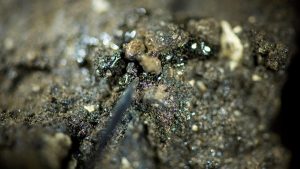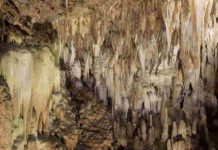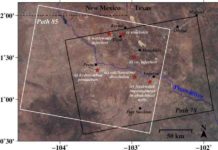
For tens of thousands of years, the warm, sticky natural asphalt that occasionally bubbled to the Earth’s surface in the area now called Los Angeles was a death sentence for some ice age animals.
Woolly mammoths, camels, rabbits, horses, bison, sloths, rodents, snails, turtles, birds and saber-toothed cats perished after becoming mired in the liquid asphalt—sometimes referred to as tar pits.
For Jacquelyn Gill, the fossils, twigs and plants encased in this sticky petroleum at the La Brea Tar Pits and Museum in downtown Los Angeles provide opportunities to examine the climate and flora and fauna of the past and observe evolutionary changes.
The University of Maine paleoecologist’s findings will be added to the broader mosaic of what’s already known about the very large animals of that era.
Gill and other scientists involved with Project 23, as it’s called, intend to reconstruct the food web—from mastodons and bison to rodents and plants—during 2,000- to 5,000-year snapshots across an approximate 50,000-year period.
“Most of these are ice age survivors,” Gill says of the animals and plants trapped in the oil seeps. “What made them so resilient to climate change and extinction?”
By reconstructing the food web, Gill and the team of researchers will learn how various species were connected for extended periods of time when they were not under climate stress.
Understanding those connections could help protect today’s biodiversity in a changing climate, she says.
“We can see how species relied on each other, and use those relationships to predict extinction risk based on food web connections,” says Gill. “It’s a useful model to apply to our modern ecosystems.”
Fossils in the tar pit tombs were unearthed recently when the Los Angeles County Museum of Art, which is adjacent to La Brea Tar Pits and Museum, excavated a site to build an underground parking garage.
Salt Lake Oil Field, a large petroleum reservoir below the Earth’s surface, is nearby. For tens of thousands of years, oil—formed from marine plankton deposited in an ocean basin 5–25 million years ago—has seeped to the surface.
The National Science Foundation funds Gill’s nearly $300,000 portion of the $1.2 million three-year project.
Gill conceived of the project when she delivered a lecture about ice age ecosystems and extinction at the Natural History Museum of Los Angeles County, which manages the Tar Pits.
“For the first time, we can look at the entire ice age ecosystem of Rancho La Brea, instead of just the largest herbivores and predators,” Gill says.
Thus far, Gill says the plants that have been identified in asphalt chunks from Los Angeles now grow in Oregon and at higher elevations in the southern Sierra Nevada mountains.
This indicates the late Pleistocene climate at La Brea Tar Pits was cooler and wetter than it is now, she says.
Note: The above post is reprinted from materials provided by University of Maine.










